Index

Review: Overclocked Edition
Recently announced Gainward GTX 470 Good Edition card comes with nonreference cooling but reference clocks, so it was only a matter of time when Gainward will launch an overclocked card as well. Today we have a card based on the GTX 470 Good’s design, but it’s dubbed more familiarly – Gainward GTX 470 Golden Sample.
Compared to the reference GTX 470, Gainward’s GTX 470 Golden Sample comes with a redesigned PCB which should provide better overclocking potential as well as better thermals.
Gainward’s GTX 470 Golden Sample comes preoverclocked – GPU runs at 650MHz, and the memory at 850MHz (reference card runs at 607MHz GPU and 837MHz memory). Apart from nonreference, dual-fan cooling, Golden sample comes with a nice set of video outs; the I/O panel features two dual-link DVIs, HDMI and DisplayPort.

The GTX 470 is based on a scaled down version of the GF100 chip, with two disabled SMs and with 448 stream processors in total. It sits in Nvidia’s GTX 400 DX 11 graphics card series and they’re aimed at AMD’s HD 5800 offer.
Packaging and contents
Gainward prepared a new box design for the new Fermi cards. Now when the company is once again Premium Nvidia partner, Gainward didn’t miss out on the chance to emphasize that on the GTX 470 Golden Sample’s box.


Due to the fact that Nvidia uses mini-HDMI out on reference designs, Gainward ships mini-HDMI cables with its reference cards. In this case however, there was no need for this as the GTX 470 Golden Sample comes with a native HDMI connector. Note that the card doesn't come with a VGA port, but Gainward ships a DVI-to-VGA dongle with the card.

A closer look at Gainward GTX 470 GS
We have in our hands one of the first GTX 470 Golden Sample cards, so it’s not quite on the shelves yet, but we know that it will be priced about €15-20 higher than reference versions. Reference GTX 470 cards are currently priced at about €310, here.

Gainward GTX 470 Golden Sample’s PCB is a bit longer than the reference GTX 470’s PCB, so you might want to check for compatibility with your case. Golden Sample is 26.7cm (10.5’’) long whereas the reference card is 24.1cm (9.5’’).

Gainward Golden Sample's cooler uses two 80mm fans. Note that most air stays within the case with only a fraction of hot air leaving the case via I/O outlets. While the cooler still cools much better than the reference once, you still might want to make sure that your in-case airflow is adequate,

Gainward GTX 470 GS cooling is two slots wide, just like on the reference GTX 470 card.
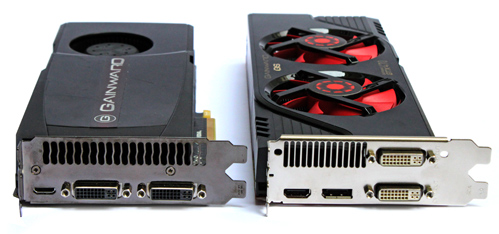
Due to lower airflow around the I/O panel, there was no need for leaving a slot reserved for air outlets, which is the case with reference card. Instead, Gainward put four video outs on its card.
The reference card uses mini-HDMI connector (which naturally requires a special cable), whereas the GTX 470 Golden Sample uses a standard HDMi connector, two dual-link DVIs and one DisplayPort connector. Gainward also included DVI-to-VGA dongle in the box.
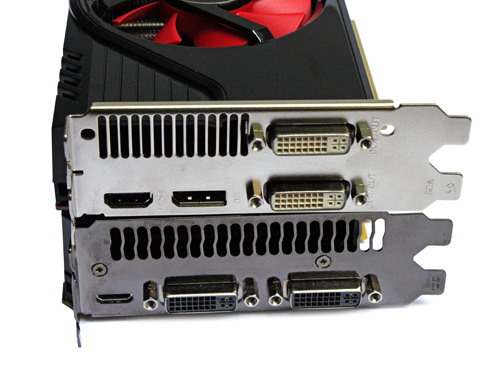
Gainward’s GTX 470 Golden Sample, GTX 470 Good and GTX 465 Good come with four video outs each, which makes these cards video-out champs among Fermi cards. Unfortunately, that won’t do you much good if you want more than two monitors at the same time, as GF100 won’t allow for more than two video outs simultaneously. The picture below shows GTX 470 GS and GTX 465 Good cards.
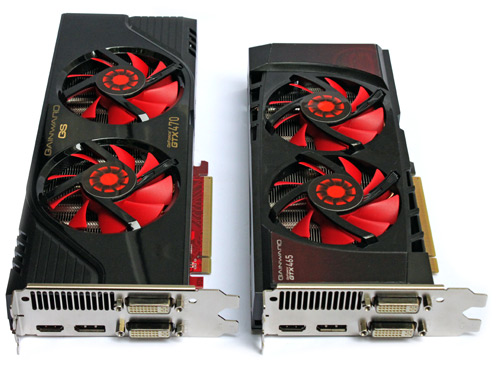
Fermi cards need no SPDIF cable; audio is routed via PCIe bus. HDMI interface is HDMI 1.3a compatible.
The base of GTX 470 GS’ cooling is a copper base with three heatpipes which route the heat to the large aluminum heatsink.
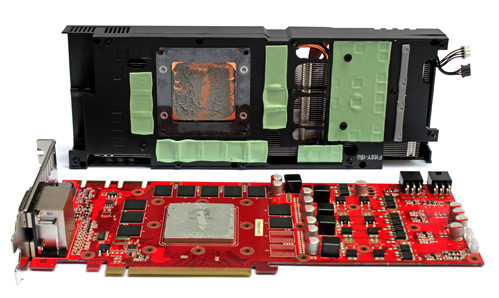
The GTX 465’s cooler takes care of memory as well as power regulation circuitry. The green areas you see on the picture are thermal components which are placed to be in direct contact with various PCB components.
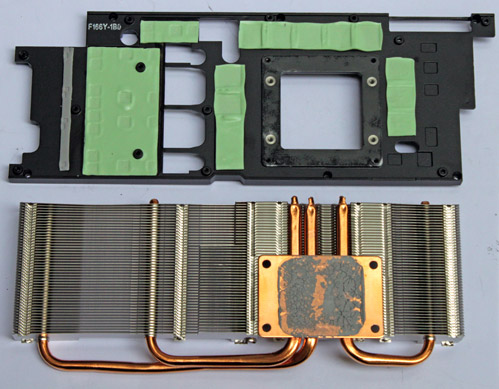
Nvidia uses GDDR5 memory on its GTX 400 cards. Gainward opted on Samsung K4G10325FE-HC05 memory rated at 1000MHz (4000MHz GDDR5 effectively). The card packs 1280MB of GDDR5 memory whereas the faster model, GTX 480, comes with 1536MB.
The reference GTX 470’s memory runs at 837MHz (3348MHz effectively), which coupled with the 320-bit memory bus gives a bandwidth of 133.9GB/s. Gainward’s GTX 470 GS has the upper hand here as its memory is clocked at 850MHz (3400MHz effectively).

If you take a look at the base of the cooler, you’ll see that one heatpipe is missing.

It’s obvious that the cooler is made with four heatpipes in mind. The four-heatpipe cooler will surely be used with the, yet unannounced GTX 480.

The fans are a part of the plastic hood that covers the heatsink.
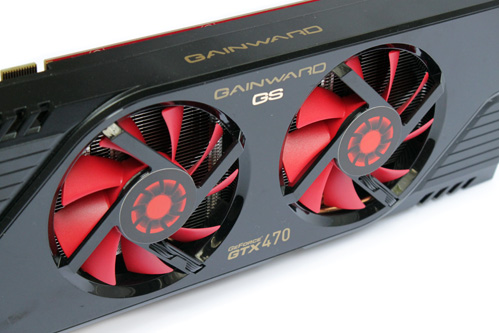
It’s interesting to see that the fans have separate 4-pin connectors, rather than the usual practice where both fans run on one 4-pin connector. Worry not though, as software RPM-speed regulation will still be a breeze.



Just like the reference card, the GTX 470 comes with two 6-pin power connectors on the upper side of the card.
OnSemi’s NCP5392 is in charge of voltage regulation and it’s possible to meddle with voltages from software.


Testbed:
Motherboard: EVGA 3xSLI
CPU: Core i7 965 XE (Intel EIST and Vdrop enabled)
Memory: 6GB Corsair Dominator 12800 7-7-7-24
Harddisk: OCZ Vertex 2 100 GB
Power Supply: CoolerMaster Ultimate 1100W
Case: Corsair Obsidian 800D
Fan Controler: Kaze Master Pro 5.25"
Operating System: Win7 64-bit
257.15_desktop_win7_winvista_64bit_english_beta
10.5 CCC
Futuremark Vantage
Gainward’s GTX 470 S is about 6% better than the reference Gainward GTX 470 but it still isn’t enough to beat the HD 5850, except perhaps in the least demanding scenarios.

Games: Dirt 2
Gainward GTX 470 GS scores about 5% better than the reference Gainward GTX 470. Although the GTX 470 GS outruns the HD 5850 at 1920x1600, it loses at 2560x1600 by 7.6% (no AA) and 9.4% (AA turned on).
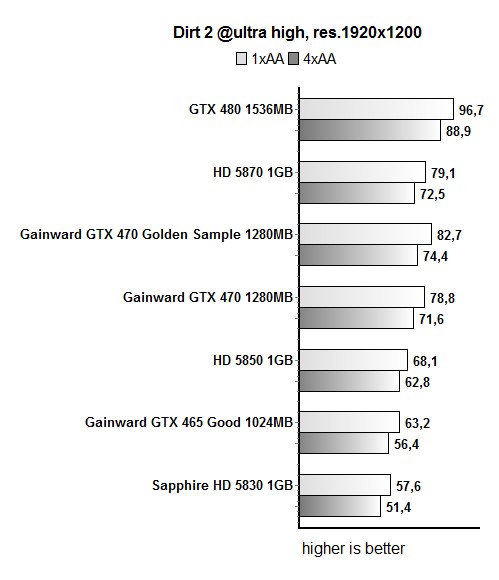
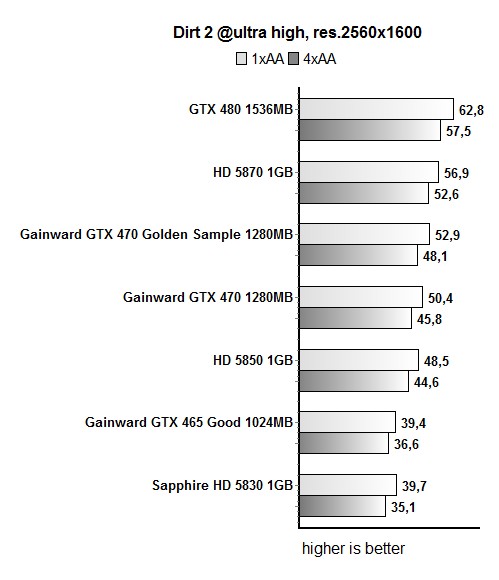
Games: Metro 2033
Metro 2033 sees no significant difference between the GTX 470 GS and the reference GTX 470, but the same goes for HD 5850 as well. At 1680x1050 and maximum detail settings, Gainward GTX 470 GS scores a playable framerate.

FurMark
FurMark seems to like GTX 470 cards, as they manage to beat the HD 5850. Gainward GTX 470 GS is only 3.6% faster than the GTX 470.

Overclocking and consumption
We must admit that overclocking Gainward’s GTX 465 Good Edition was a breeze, which isn’t quite the case with reference GTX 470 cards we tested. Naturally, we’re talking about Gainward’s GTX 470 Golden Sample so our expectations were pretty high.
GTX 470 GS comes pre-overclocked, albeit not much higher than reference, but it was still enough to record 6% better results compared to the reference card.
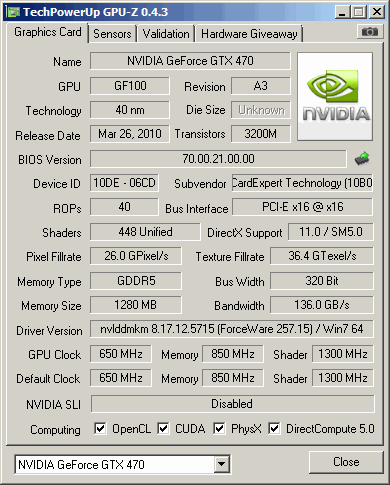
Gainward GTX 470 GS proves that it’s better in overclocking than the cards based on reference design and cooling. We managed to push the card to 760MHz (note that shaders run at double the speed). We couldn’t push the memory all the way to 1GHz, which should be supported by Samsung’s K4G10325FE-HC05 memory; we ended up running the memory at 965MHz.

All in all, the “overclockability” of GTX 470 GS card was still nowhere near its little brother – the GTX 465 Good, which we managed to push to 790MHz for the GPU and 1000MHz for the memory.
Since the GTX 470 Golden Sample supports voltage regulation via software, we used MSI’s Afterburner v.1.6.0 beta5 to push the GPU to 800MHz (1000mV). The memory couldn’t catch up with the GPU so we lowered it from 965MHz to 950MHz. Note however that in order to get 800MHz on the GPU, we had to push the fans to maximum RPM. We must admit that the fans were unbearably loud, but they did the job well and managed to keep the GPU at 92°C.

Gainward GTX 470 GS’ out-of-the-box temperatures linger around 87°C, which is 6°C lower than on the reference GTX 470. This is clear proof that Gainward did a good job, and that its cooling is clearly superior to Nvidia’s.
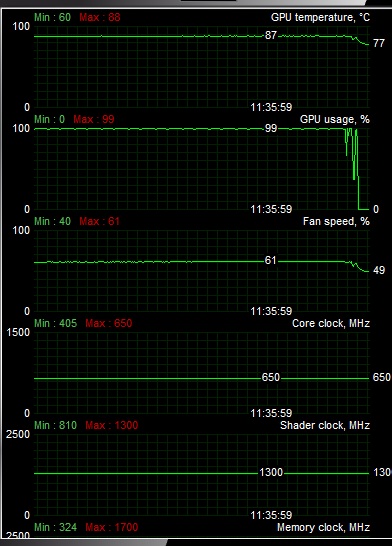
We already said that this cooler can use four heatpipes, one more than it has on the GTX 470 GS. If the cooler had the additional heatpipe, we suspect that temperatures would be lower and the fans could make less noise. This way, the GTX 470 GS was only slightly quieter than the reference – meaning you’ll easily hear it, although it’s not unbearably loud. We measured 44°C in idle mode whereas the reference GTX 470 has 43°C.
Gainward GTX 470 GS is only 3.6% faster than the reference version in FurMark, but our overclocking (800MHz GPU and 950MHz memory) resulted in 20.9% better scores. Overclocking the GTX 470 GS provided us with 16.7% better results.

Vantage Performance gives us the result of the day – the overclocked Gainward GTX 470 Golden Sample manages to beat the GTX 480. In this test, overclocking boosted the GTX 470 GS results by 25.3%.

Power Consumption
In idle mode, Gainward’s GTX 470 Golden Sample card consumes about the same as the reference GTX 470.
Our entire rig with the GTX 470 GS card cozily sitting inside, consumed maximum 433W in 3D. Additional overclocking pushed the consumption to 524W. 3D consumption is expectedly higher compared to the reference card (395W), since the Golden Sample card is overclocked.
Unfortunately for the green team, Radeon HD 5850 is much better in this respect as our test rig consumed 308W with 5850 inside. Idle operation again sees the HD 5850 take the cake as our test rig drew about 146W. The same scenario with the GTX 470 resulted in 149W whereas the GTX 470 Golden Sample drew 152W.
Conclusion
Gainward GTX 470 Golden Sample is the first nonreference GTX 470 we received and it did pretty well on our tests. The card comes preoverclocked to 650MHz for the GPU and 850MHz for the memory, which isn’t a radical change from the reference clocks (607MHz GPU, 837MHz memory), but it’s enough for the card to score up to 5% better than the reference card.
One of the points where Gainward’s Golden Sample takes the cake compared to the reference card is the cooling. Gainward’s GTX 470 GS comes with a more efficient cooling solution which is good enough to cool the GPU overclocked to 800MHz, which was our maximum overclock.
Superior cooling almost always spelss nice overclocking potential, but the cooling isn’t much quieter than the reference cooling in auto mode. This, however, doesn’t mean that the noise is unbearable but rather that you’ll hear it when sitting next to the computer. Thankfully, the Gainward Golden Sample’s GPU ran about 6°C cooler, so you can always sacrifice some thermals to get some more silence.
Gainward GTX 470 Golden Sample’s pricing isn’t fixed yet, but we were told it should be priced some €15 to €20 more than reference GTX 470 cards.
So let’s recap – nice overclocking potential, superior cooling and a better set of video outs than on the reference card are the main things that make Gainward’s GTX 470 Golden Sample stand out of the crowd. If you’re looking to buy a GTX 470, you might want to wait for Gainward’s GTX 470 Golden Sample, and if the pricing is indeed €15 to €20 more, you won’t regret the wait.
